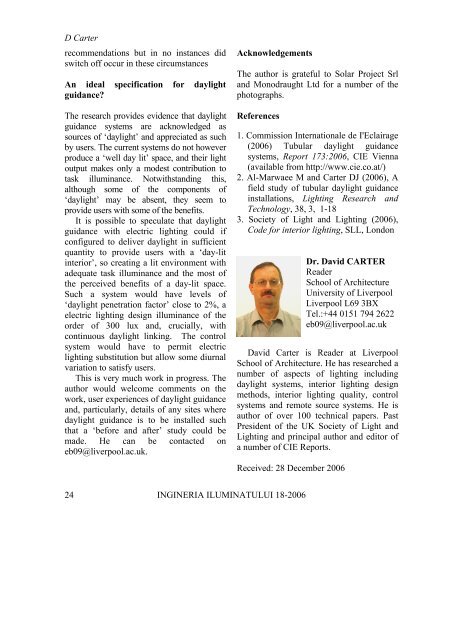This issue is sponsored by the Philips Romania, Lighting Division
This issue is sponsored by the Philips Romania, Lighting Division
This issue is sponsored by the Philips Romania, Lighting Division
You also want an ePaper? Increase the reach of your titles
YUMPU automatically turns print PDFs into web optimized ePapers that Google loves.
D Carter<br />
recommendations but in no instances did<br />
switch off occur in <strong>the</strong>se circumstances<br />
An ideal specification for daylight<br />
guidance?<br />
The research provides evidence that daylight<br />
guidance systems are acknowledged as<br />
sources of ‘daylight’ and appreciated as such<br />
<strong>by</strong> users. The current systems do not however<br />
produce a ‘well day lit’ space, and <strong>the</strong>ir light<br />
output makes only a modest contribution to<br />
task illuminance. Notwithstanding th<strong>is</strong>,<br />
although some of <strong>the</strong> components of<br />
‘daylight’ may be absent, <strong>the</strong>y seem to<br />
provide users with some of <strong>the</strong> benefits.<br />
It <strong>is</strong> possible to speculate that daylight<br />
guidance with electric lighting could if<br />
configured to deliver daylight in sufficient<br />
quantity to provide users with a ‘day-lit<br />
interior’, so creating a lit environment with<br />
adequate task illuminance and <strong>the</strong> most of<br />
<strong>the</strong> perceived benefits of a day-lit space.<br />
Such a system would have levels of<br />
‘daylight penetration factor’ close to 2%, a<br />
electric lighting design illuminance of <strong>the</strong><br />
order of 300 lux and, crucially, with<br />
continuous daylight linking. The control<br />
system would have to permit electric<br />
lighting substitution but allow some diurnal<br />
variation to sat<strong>is</strong>fy users.<br />
<strong>Th<strong>is</strong></strong> <strong>is</strong> very much work in progress. The<br />
author would welcome comments on <strong>the</strong><br />
work, user experiences of daylight guidance<br />
and, particularly, details of any sites where<br />
daylight guidance <strong>is</strong> to be installed such<br />
that a ‘before and after’ study could be<br />
made. He can be contacted on<br />
eb09@liverpool.ac.uk.<br />
24<br />
Acknowledgements<br />
The author <strong>is</strong> grateful to Solar Project Srl<br />
and Monodraught Ltd for a number of <strong>the</strong><br />
photographs.<br />
References<br />
1. Comm<strong>is</strong>sion Internationale de I'Eclairage<br />
(2006) Tubular daylight guidance<br />
systems, Report 173:2006, CIE Vienna<br />
(available from http://www.cie.co.at/)<br />
2. Al-Marwaee M and Carter DJ (2006), A<br />
field study of tubular daylight guidance<br />
installations, <strong>Lighting</strong> Research and<br />
Technology, 38, 3, 1-18<br />
3. Society of Light and <strong>Lighting</strong> (2006),<br />
Code for interior lighting, SLL, London<br />
Dr. David CARTER<br />
Reader<br />
School of Architecture<br />
University of Liverpool<br />
Liverpool L69 3BX<br />
Tel.:+44 0151 794 2622<br />
eb09@liverpool.ac.uk<br />
David Carter <strong>is</strong> Reader at Liverpool<br />
School of Architecture. He has researched a<br />
number of aspects of lighting including<br />
daylight systems, interior lighting design<br />
methods, interior lighting quality, control<br />
systems and remote source systems. He <strong>is</strong><br />
author of over 100 technical papers. Past<br />
President of <strong>the</strong> UK Society of Light and<br />
<strong>Lighting</strong> and principal author and editor of<br />
a number of CIE Reports.<br />
Received: 28 December 2006<br />
INGINERIA ILUMINATULUI 18-2006
















